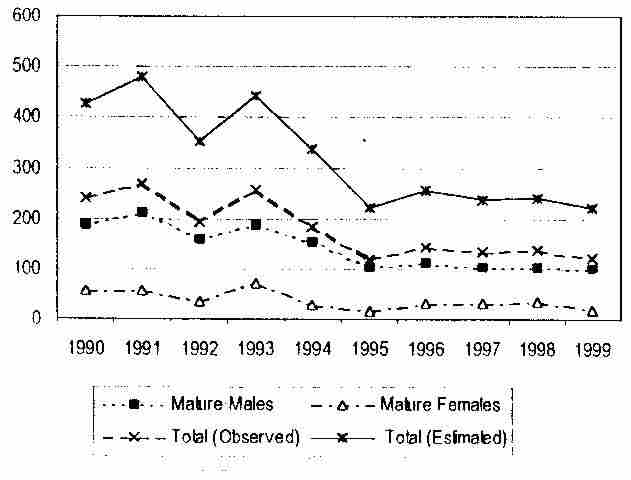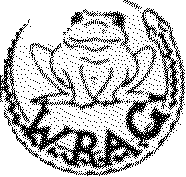
By Sylvia Sheldon
(Sylvia Sheldon has been undertaking an important study of adders in Wyre Forest for many years. The following is extracted from her year 2000 report with her permission. Ed)
| Year | SitesSurveyed | Sites withadders | Maturemales | Maturefemales | Total | Average Per site |
| 1990 | 56 | 50 | 185 | 55 | 240 | 4.8 |
| 1991 | 76 | 61 | 211 | 56 | 267 | 4.4 |
| 1992 | 78 | 55 | 159 | 33 | 192 | 3.5 |
| 1993 | 80 | 59 | 186 | 70 | 256 | 4.2 |
| 1994 | 76 | 50 | 153 | 29 | 182 | 3.6 |
| 1995 | 76 | 44 | 103 | 14 | 117 | 2.6 |
| 1996 | 80 | 41 | 112 | 32 | 144 | 3.5 |
| 1997 | 84 | 44 | 102 | 31 | 133 | 3.0 |
| 1998 | 85 | 42 | 103 | 34 | 137 | 3.3 |
| 1999 | 67 | 35 | 100 | 20 | 120 | 3.4 |
| 2000 | 87 | 24 | 69 | 13 | 82 | 3.4 |
Table 1: Adder numbers
| Year | Firstsighting | Air temp(ºC) | Grass temp.(ºC) | Firstslough |
| 1990 | 5 Feb | 13.0 | 14.0 | 08 Apr |
| 1991 | 23 Feb | 14.0 | 17.0 | 19 Apr |
| 1992 | 23 Feb | 13.0 | 15.0 | 22 Apr |
| 1993 | 17 Feb | 10.7 | 12.5 | 16 Apr |
| 1994 | 10 Feb | 10.0 | 15.0 | 18 Apr |
| 1995 | 12 Feb | 11.4 | 11.0 | 10 Apr |
| 1996 | 16 Feb | 12.2 | 15.0 | 24 Apr |
| 1997 | 15 Feb | 8,6 | 11.0 | 08 Apr |
| 1998 | 11 Feb | 13.6 | 12.5 | 17 Apr |
| 1999 | 16 Feb | 8.0 | 9.0 | 16 Apr |
| 2000 | 19 Feb | 6.3 | 12.5 | 07 Apr |
Table 2: Emergence and sloughing dates of adders
| Year | Grass snakes | Slow-worms | Lizards | |||
| Mature | Juv | Mature | Juv | Mature | Juv | |
| 1990 | 30 | 6 | 23 | 3 | 22 | 2 |
| 1991 | 16 | 4 | 24 | 11 | 20 | 0 |
| 1992 | 22 | 8 | 27 | 8 | 10 | 3 |
| 1993 | 45 | 4 | 57 | 5 | 35 | 3 |
| 1994 | 18 | 2 | 36 | 10 | 22 | 1 |
| 1995 | 19 | 4 | 23 | 13 | 11 | 0 |
| 1996 | 18 | 4 | 32 | 16 | 15 | 0 |
| 1997 | 25 | 3 | 42 | 11 | 42 | 0 |
| 1998 | 20 | 1 | 34 | 8 | 37 | 0 |
| 1999 | 26 | 8 | 32 | 9 | 18 | 1 |
| 2000 | 11 | 1 | 21 | 3 | 23 | 0 |
Table 3: Other reptiles recorded in Wyre Forest during adder census

Chart shows Adder population trends 1990 to 2000
| The result of the spring Census for 2000 has given
great cause for concern. The number of mature adders
recorded in Wyre Forest plummeted to an all-time low of
only 82 individuals, including just 13 females. Of these
females, only three were seen in the company of males.
Poor weather in the summer of 1999 could have accounted
for this, preventing females from feeding and building up
fat reserves sufficient to permit them to breed. A cool
wet September that year may also have delayed birth in
pregnant females. These would then have had to hibernate
still pregnant, and give birth as soon as the weather in
spring 2000 was warm enough. This appears to have happened in at least three cases. These females were seen initially to be plump and apparently in breeding condition, but by the end of April they were much thinner, as if parturition had occurred. An apparently newborn infant adder was found in the vicinity of one of the females. None of them attracted a male, and overall the evidence seems conclusive. The other seven females seen in March 2000 had all disappeared by the time mating courtship began, and they did not participate either. The effects of the summer of 1999 on the females appears obvious from the Census results. The effects on the male and the juvenile populations is unknown, other than indicated by the Census indicates - that many did not survive hibernation! Of the 87 currently or previously occupied sites surveyed in Wyre Forest, only 24 were found to support adders in 2000. Other sites were surveyed in Worcestershire during the spring, six were found to support adders with 22 males and seven females recorded. This brings the total overall to 111 mature adders in Worcestershire and the Wyre Forest (part of which is in Shropshire). Of these 91 are males and only 20 females. This represents another sharp decline in numbers and suggests that the future for adders in this survey area is bleak. AcknowledgementsI would like to thank: Chris Bradley, Jeff Hubball and Nigel Hand for their census work, .all those who reported reptile sightings and the landowners on whose property the study has been undertaken. Address for Communications: Ms Sylvia Sheldon, Knowles Mill, Dowles Brook, Wyre Forest, near Bewdley Worcestershire. DY12 2LX. |
Original Artwork: Denys Ovenden
 |
WORCESTERSHIRE
|
Reference
| SHELDON, SYLVIA February 2001. Wyre Forest Adder census and report 2000: correlated with local meteorological data. |
| WBRC Home | Worcs Record Listing by Issue | Worcs Record Listing by Subject |